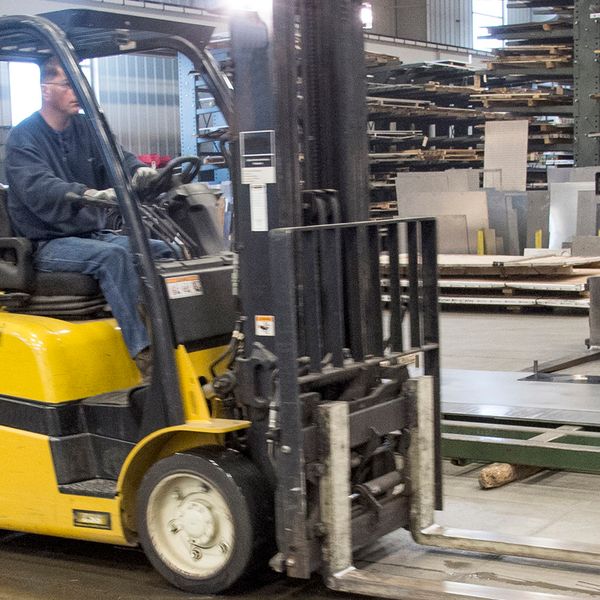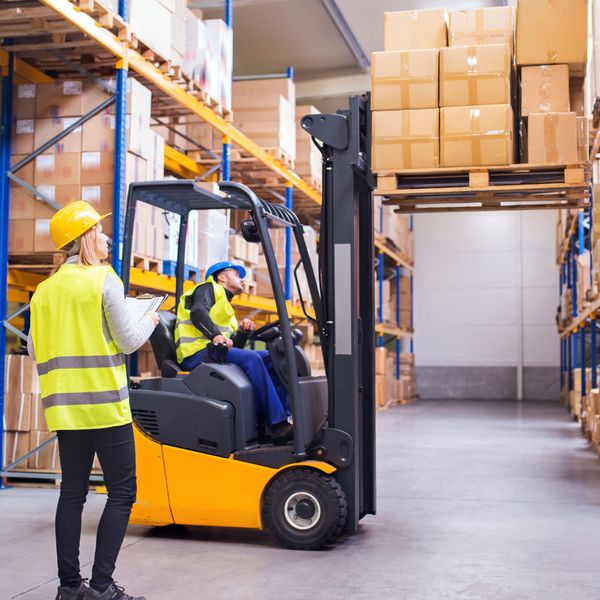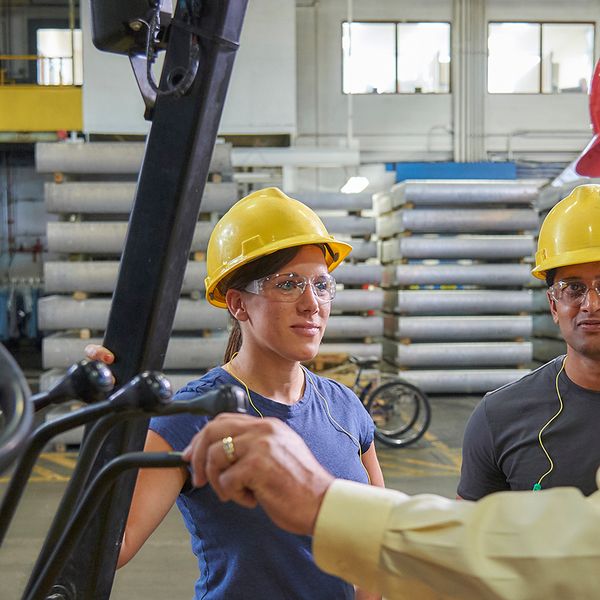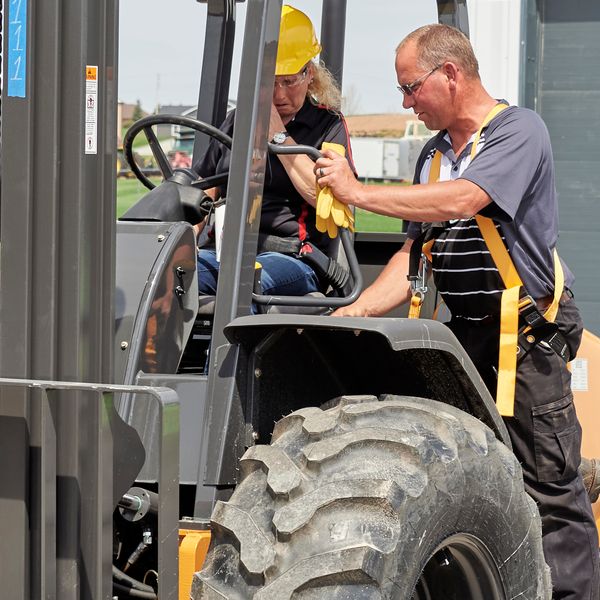Telehandler Handout
Unseating telehandler licensing and certification myths
The criteria for telehandler safety are found in OSHA’s Powered Industrial Trucks Standard at 1910.178(l), applicable to construction work. Understanding these requirements is a necessary task for operators. Fortunately, the regulations are straightforward, but two common forklift myths continue to confuse management: licensing and certification.
Licensing
Do telehandler operators need to have a valid state vehicle drivers’ license? OSHA says that a license is not needed. When on the jobsite, a project-level certification that the operator has completed training based on OSHA’s requirements in 1910.178(l) is all that is necessary.
However, if the operator is driving between jobsites or on the right-of-way on a public roadway (under local traffic laws), a valid state driver’s license is needed.
Certification
It’s customary practice to issue a certificate or card to workers when they have completed training. Doing this is not needed. OSHA only requires that operators be certified by their company after conducting proper training and evaluating the operator’s skills. The requirements in 1910.178(l)(6) state the certification must include “the name of the operator, the date of the training, the date of the evaluation, and the identity of the person(s) performing the training or evaluation.”
The training must be documented, but the requirements don’t specify that a license must be issued. As such, the company may issue a certificate, card, or simply place a signed training document in the worker’s personnel file.
However, be aware that certain states (e.g., Michigan) do require forklift operators to carry a wallet-type license showing that they are qualified to operate a forklift vehicle.
The most common training questions answered
OSHA estimates approximately 1.5 million workers in the United States operate various powered industrial trucks, of which telehandlers are perhaps the most common on construction sites. Each of these operators must receive training before being allowed to operate the equipment.
While OSHA’s telehandler training requirements are straightforward for many issues (i.e., the requirement that operators need training), some confuse operators and project management.
Who can conduct telehandler training?
Perhaps the most confusing of OSHA’s telehandler training requirements concerns the qualification of trainers. OSHA requires that the training/evaluation be conducted by someone who has the “knowledge, training, and experience” to train operators and evaluate their competence. The OSHA Standard does not further define this requirement or mandate any specific trainer certifications.
It’s up to the jobsite to ensure that the person conducting the training is qualified and capable; this expertise can be acquired in many ways, from years of experience as an operator to attending a train-the-trainer course. However, OSHA requires the trainer to have experience operating the types of equipment, including attachments, to be used in training, though the trainer need not operate the equipment as a regular part of job duties.
Further, management needs to ensure that the designated trainer can communicate the concepts to trainees and commit to ensuring trainees have the skills and knowledge necessary.
A new worker had training at his prior jobsite. Does he need to be retrained at his new project?
OSHA requires that workers receive training before operating telehandlers in the workplace. This training must be worksite and truck specific. There is a provision in the OSHA powered industrial truck operator training requirements to avoid “duplicative” training. There is usually the need for site-specific training, including training on unique aspects of equipment (such as location and function of controls) and unique jobsite characteristics (such as rough terrain and uneven surfaces onsite).
OSHA requires operators to be evaluated before being allowed to operate telehandlers on their jobsite, regardless of whether they have prior training with another company.
At the very least, the new jobsite must conduct a performance evaluation and certify that it has been done, as well as provide any truck or workplace-specific training. More training may or may not be needed, depending on the evaluation results, types of truck, and other factors.
When does refresher training need to be conducted?
OSHA requires refresher training on relevant topics when one or more of five specific situations occur; there is no set frequency. The situations requiring refresher training are:
- The operator has been observed to operate the vehicle in an unsafe manner;
- The operator has been involved in an accident or near-miss incident;
- The operator has received an unsatisfactory evaluation;
- The operator is assigned to drive a different type of truck; or
- A condition on the jobsite changes in a manner that could affect safe operation of the truck.
Would a written exam alone (i.e., without the truck’s practical operation) suffice for the required 3-year operator evaluation?
OSHA has said that a written exam cannot meet the “evaluation” of “performance” alone. A written exam by itself does not show whether the operator is safely operating the powered industrial truck safely.
OSHA expects that, in most cases, the person conducting the evaluation do two things:
- First, observe the powered industrial truck operator during normal operations to determine if the operator is performing safely, and
- Second, ask pertinent questions to ensure that the operator has the knowledge or experience needed to operate a truck safely.
In some cases, because of the danger or complexity of the operation, the extent of the change in conditions, or the operator’s need for additional skills, the evaluation will need to be lengthier and more detailed. Note that the evaluation should be done by someone who is qualified to train operators, not just a jobsite foreman. The OSHA regulation at 1910.178(l)(2)(iii) says, “All operator training and evaluation shall be conducted by persons who have the knowledge, training, and experience to train powered industrial truck operators and evaluate their competence.”
Do we have to train when workers operate the same type of truck made by a different manufacturer?
OSHA generally only requires additional training/evaluation when the operator is assigned a different “type” of a truck he has been trained/evaluated previously. For example, suppose an operator has been trained only to operate a sit-down lift truck. In that case, the operator needs additional training/evaluation before using a stand-up unit or an order picker. However, the operator would not require further training/evaluation to operate another sit-down truck made by a different manufacturer (except for any significant differences).
Evaluating training
There are many confusing issues when it comes to forklift operator training. Many can be answered by looking closely at the text of OSHA’s telehandler operator training requirements at 1910.178(l). Others can be found in OSHA LOIs. Finally, the ANSI/ITSDF industry standard B56.1, Safety Standard for Low Lift and High Lift Trucks, fills in many gaps. Make sure all operators receive a truck, and workplace-specific training and performance are closely monitored, with refresher training when changes or issues arise.


















































